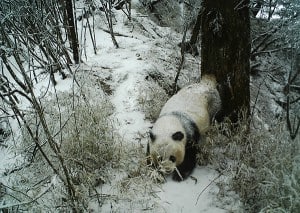Share this article
GPS Collars Give a Glimpse of the Secret Life of Pandas
One of China’s most iconic yet elusive mammal species has just stepped into the spotlight, and its social life is a little busier than previously believed.
A new study reveals that giant panda bears (Ailuropoda melanoleucaI) in China’s Sichuan province interact with each other and begins to map individual animal ranges in the bamboo forests.
“They’re very difficult to see in the wild. They avoid people,” said Vanessa Hull, a post-doctoral researcher at the Center for Systems Integration and Sustainability Michigan State University and the lead author of a study released recently in the Journal of Mammalogy.

Pandas advertise their presence with scent marking — rubbing odorous glands against trees to broadcast information about who they are, their location and their mating status.
Image Credit: Michigan State University Center for Systems Integration and Sustainability
But an international team including Hull from MSU and researchers from the Chinese Academy of Sciences captured five wild pandas in the Wolong Nature Preserve and equipped them with GPS collars to track their movements over four years — something that hasn’t been done for a decade due to a government moratorium on telemetry tracking of giant pandas in China.
They found that the pandas are more social than previously believed, hanging out together for periods outside regular mating season. “It was pretty fascinating to look at this from a biology perspective,” Hull said.
They also found that individual pandas tended to occupy fairly small ranges considering their size — around 1.15 square miles to 2.3 square miles. But within these areas the bears would occupy as many as 30 core areas, shifting between areas and circling back to the same places months later.
“If they eat their way out of the area where they’re at, they need to move on,” Hull said, noting that the low-digestion rate pandas have for their preferred bamboo food source means they have to eat a lot of it. “The technology allowed us to see this pattern unfolding over time.”
Watch a video of wild Pandas roaming in the Wolong Nature Reserve in the Sichuan Province of southwest China.
Header Image:
A camera trap captures a panda walking through the snow in the Wolong Nature Reserve in Sichuan, China.
Image Credit: Michigan State University Center for Systems Integration








